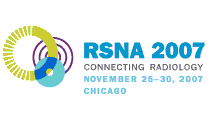
Abstract Archives of the RSNA, 2007
SSC09-09
Early Prediction of Therapeutic Response of Liver Metastases from Colorectal Cancer to Hepatic Arterial Infusion Chemotherapy Using Diffusion-weighted MR Image
Scientific Papers
Presented on November 26, 2007
Presented as part of SSC09: Gastrointestinal (CT/MR Perfusion: Liver)
Nagaaki Marugami, Presenter: Nothing to Disclose
Toshihiro Tanaka MD, Abstract Co-Author: Nothing to Disclose
Shinji Hirohashi MD, Abstract Co-Author: Nothing to Disclose
Satoru Kitano MD, Abstract Co-Author: Nothing to Disclose
Hiroshi Sakaguchi MD, Abstract Co-Author: Nothing to Disclose
Kimihiko Kichikawa MD, Abstract Co-Author: Nothing to Disclose
Aki Takahashi, Abstract Co-Author: Nothing to Disclose
Masahiro Inoue, Abstract Co-Author: Nothing to Disclose
Hideyuki Nishiofuku MD, Abstract Co-Author: Nothing to Disclose
et al, Abstract Co-Author: Nothing to Disclose
et al, Abstract Co-Author: Nothing to Disclose
The ability to predict response of liver metastases from colorectal cancer to hepatic arterial infusion (HAI) chemotherapy may be important to permit repeat chemo infusion or early changes in treatment. The purpose of this study is to investigate whether diffusion-weighted MR image (DWI) were useful for early prediction of therapeutic response to HAI.
The subjects were 8 patients with 29 metastatic liver tumors from colorectal cancer. A catheter with property of anticoagulation was placed into the hepatic artery angiographically. The proximal end of the catheter was connected to implantable port, and the whole system was embedded subcutaneously. 5-FU was infused at a dose of 1000mg/m2/day over 5hours once a week, and this therapy was repeated for three months. MR images were acquired before and at 9 days following the initiation of HAI for early prediction of therapeutic response. The minimum apparent diffusion coefficient (ADC) values of each tumor were recorded. The final evaluation of therapeutic tumor response was determined by CT images three months after initiating HAI and tumor reduction ratio was calculated.
In 16 of 29 lesions, the tumor volume was decreased three months after HAI (responder). In the remaining 13 lesions, the tumor volume was increased or not changed (non-responder). Relative change in minimum ADC value; %ADC=(ADC day9 – ADC pre) / ADC pre of responder was statistically greater than that of non-responder (17.9±17.7 vs -10.5±10.4, p<0.001). Positive correlation between %ADC and tumor reduction ratio was recorded (r=0.65, p<0.001).
The minimum ADC value on DWI is a promising tool for early prediction of therapeutic response of liver metastases from colorectal cancer to HAI chemotherapy.
The ADC value on DWI is a promising tool for early prediction of therapeutic response to hepatic arterial infusion chemotherapy so that it may be useful for judgment of therapeutic strategy.
Marugami, N,
Tanaka, T,
Hirohashi, S,
Kitano, S,
Sakaguchi, H,
Kichikawa, K,
Takahashi, A,
Inoue, M,
Nishiofuku, H,
et al, ,
et al, ,
Early Prediction of Therapeutic Response of Liver Metastases from Colorectal Cancer to Hepatic Arterial Infusion Chemotherapy Using Diffusion-weighted MR Image. Radiological Society of North America 2007 Scientific Assembly and Annual Meeting, November 25 - November 30, 2007 ,Chicago IL.
http://archive.rsna.org/2007/5013339.html

